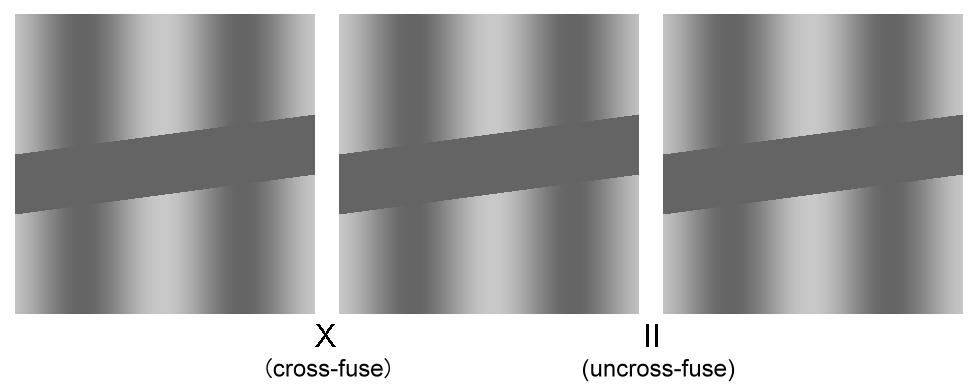
The "grounds" of the inducing gratings appears to be light while the "figures" (that are continual with phantoms) appear to be dark.
Symposium: Adaptation, brightness, and contrast
ECVP 2005 in A Coruña, Spain (August 22-26, 2005)
The visual phantom illusion: a perceptual product of surface completion depending on brightness and contrast
Akiyoshi Kitaoka (Ritsumeikan University), Jiro Gyoba (Tohoku University)
and Kenzo Sakurai (Tohoku Gakuin University)
Presented August 23, 2005, using this page Summary
Continued from the previous page
Figure-ground segregation in the inducing gratings: Interpolation

The "grounds" of the inducing gratings appears to be light while
the "figures" (that are continual with phantoms) appear to be
dark.
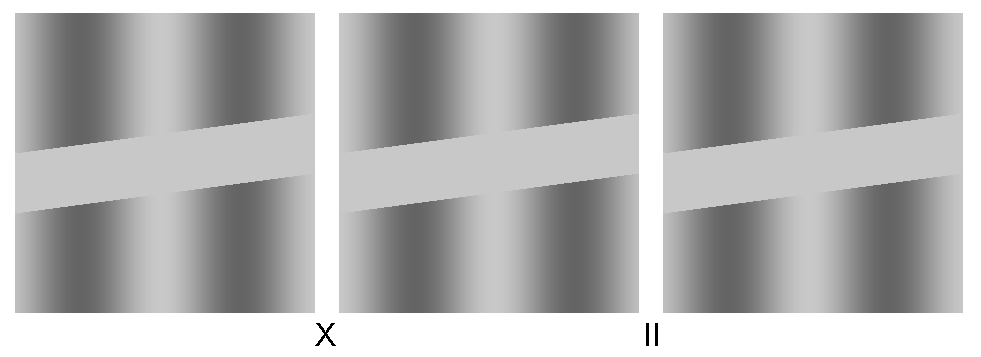
The "grounds" of the inducing gratings appears to be dark while
the "figures" (that are continual with phantoms) appear to be
light.
Brown J. M. and Weisstein, N. (1991) Conflicting figure-ground and depth information reduces moving phantom visibility. Perception, 20, 155-65.
Figure-ground segregation in visual phantoms: Extrapolation
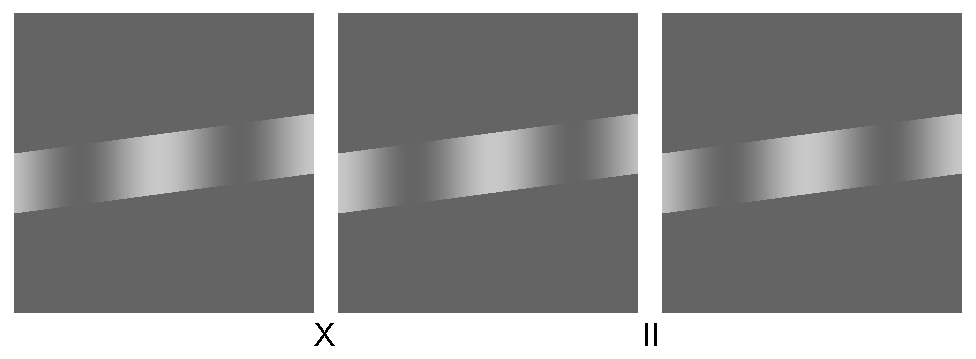
The "grounds" of the inducing gratings appears to be light while
the "figures" (that are continual with extrapolated phantoms)
appear to be dark.
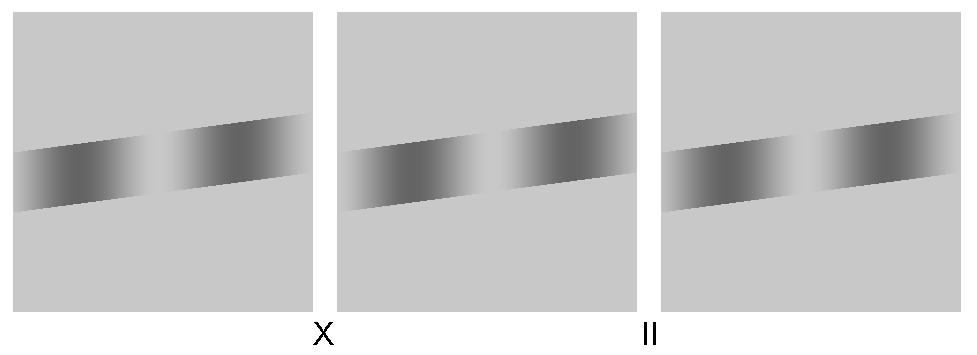
The "grounds" of the inducing gratings appears to be dark while
the "figures" (that are continual with extrapolated phantoms)
appear to be light.
Gyoba, J. (1996) Perceptual extrapolation of a stereoscopically raised surface depends upon its spatial frequency content. Investigative Ophthalmology and Visual Science, 37, 284.
Anderson, B. L. (1999) Stereoscopic surface perception. Neuron, 24, 919-928.
Figure-ground segregation of visual phantoms give lightness illusion
Quiz 1
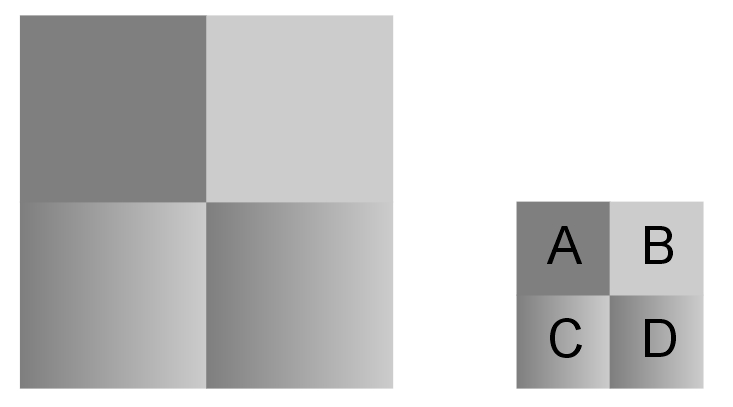
Which pair of squares are the same in luminance among a-d?
Quiz 2
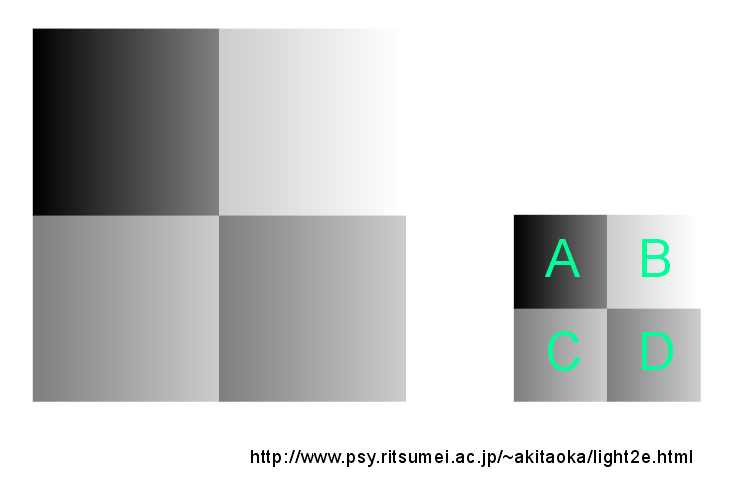
Which pair of squares are the same in luminance among a-d?
If this configuration is already known, please let me know.
Example of in-phase gradients
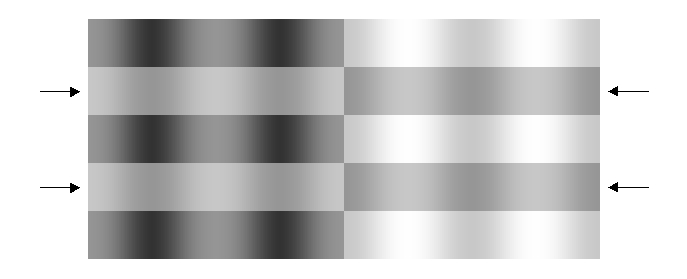
Portions indicated by arrows have the same mean luminance.
Gradient-based simultaneous brightness contrast
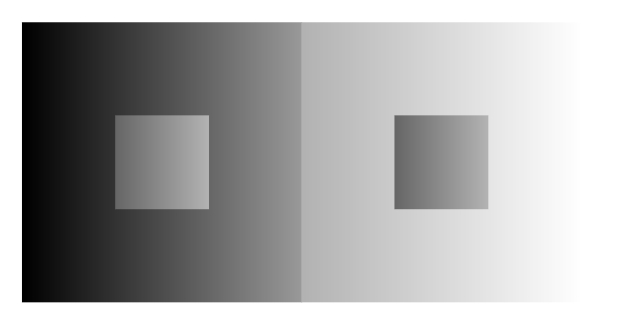
Both squares are identical in luminance gradient.
Both squares are identical in luminance gradient.
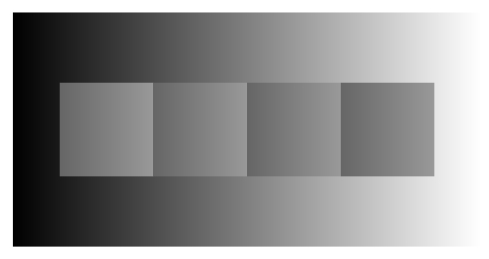
The four squares are identical in luminance gradient.
Our claim: Some of the lightness illusions are related to the visual phantom illusion.
Quiz 3
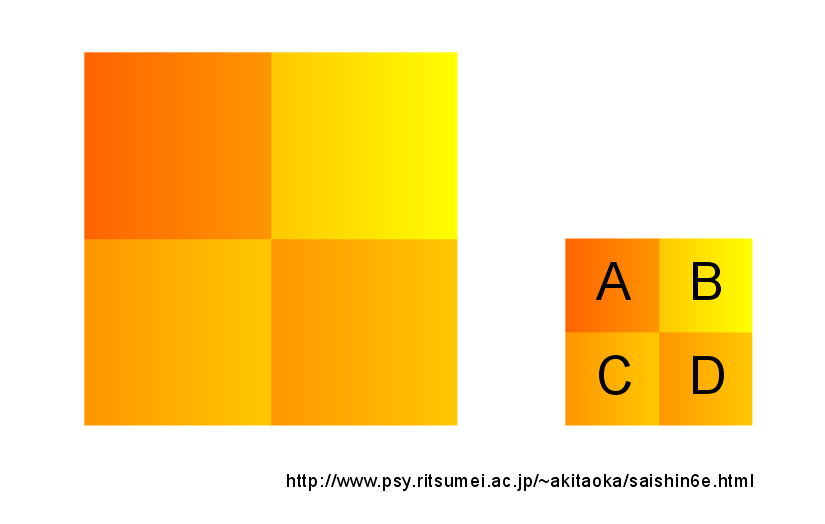
Which pair of squares are the same in color among a-d?
Quiz 4
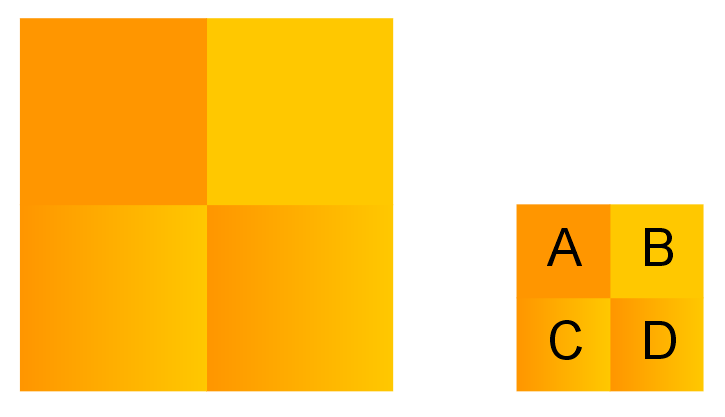
Which pair of squares are the same in color among a-d?
Color phantoms

Our claim: Some of the color illusions are also related to the visual phantom illusion.
Square-wave visual phantoms and Kanizsa figures
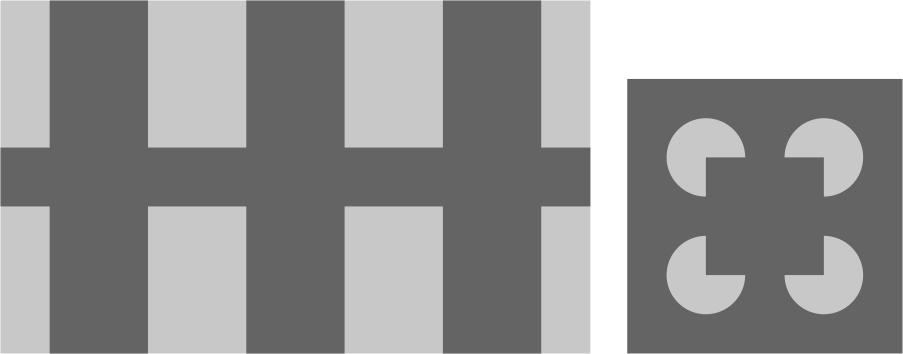
Left panel: Dark phantoms appear in front. Right panel: A dark illusory square appears in front.
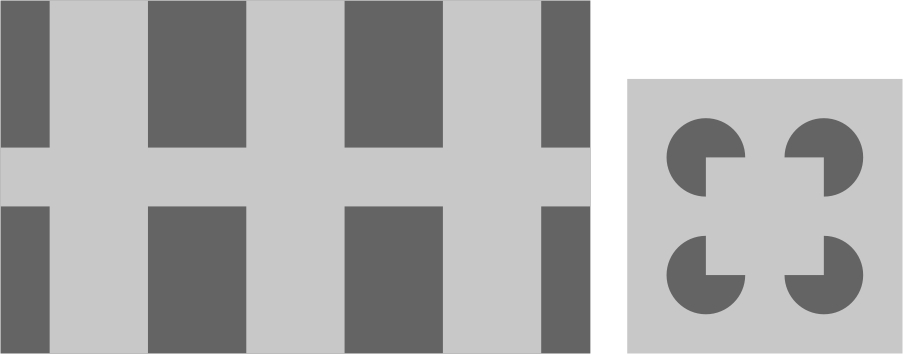
Left panel: Light phantoms appear in front. Right panel: A light illusory square appears in front.
Gyoba, J. (1983). Stationary phantoms: A completion effect without motion and flicker. Vision Research, 23, 205-211.
Sine-wave Kanizsa figures and visual phantoms
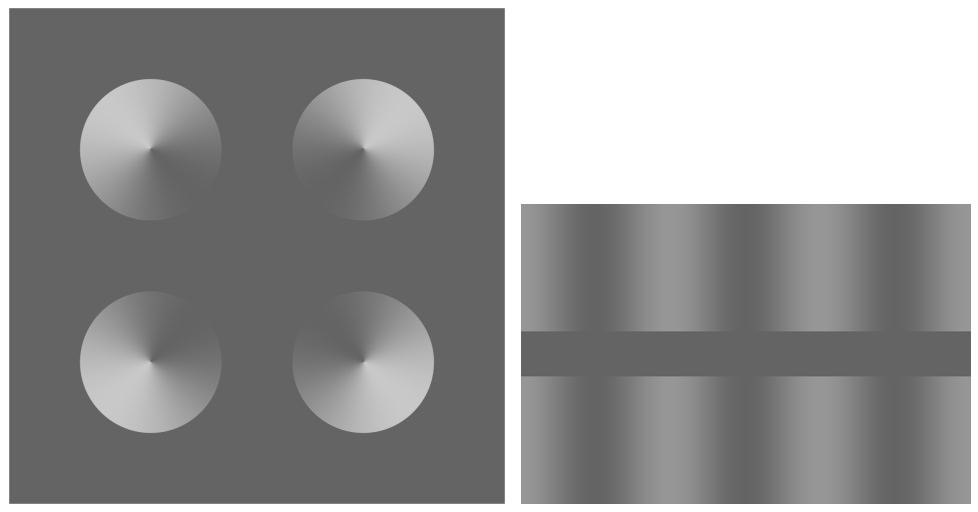
Left panel: Dark illusory mist appear in front. Right panel: Dark phantoms appears in front.
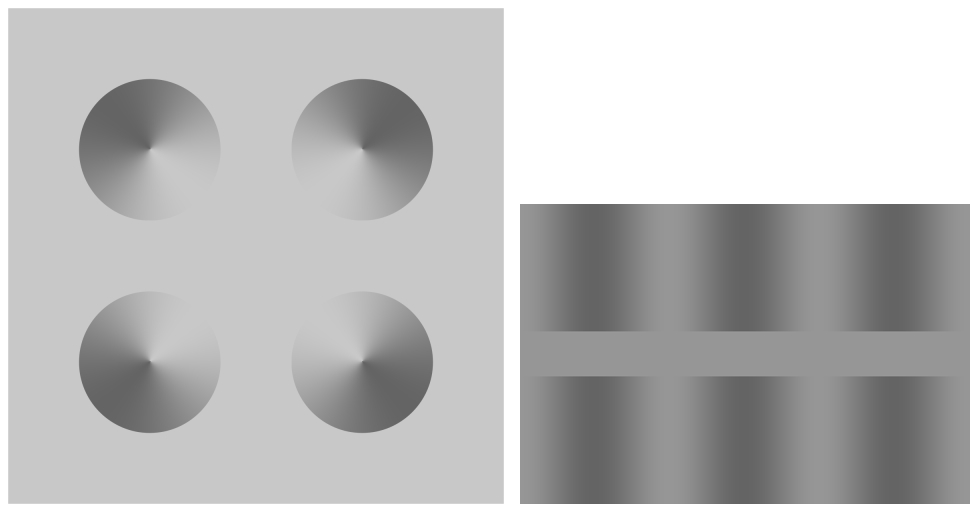
Left panel: Light illusory mist appear in front. Right panel: Light phantoms appears in front.
Our claim: The Kanizsa illusion is also related to the visual phantom illusion.
Envelope phantoms
Low-contrast areas given by contrast modulation can form visual phantoms.
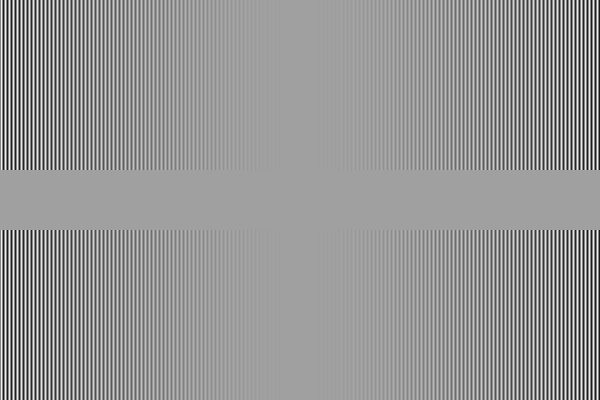
Low-contrast areas first gives perceptually transparent layers in front of the carrier. Then, the illusory surfaces are completed over the occluder (= visual phantoms).
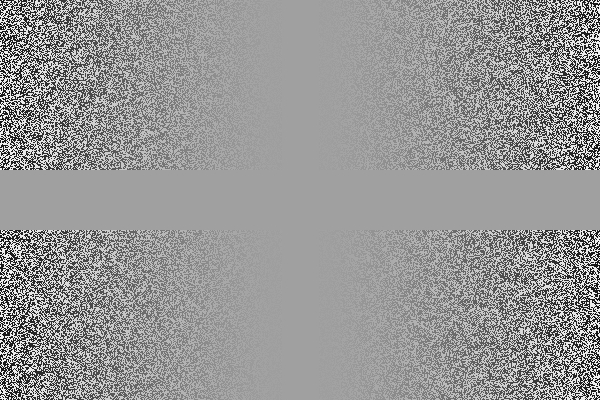
Gyoba, J., Sasaki, H., & Sakurai, K. (2000) Visual phantoms can be produced by second-order gratings. Investigative Ophthalmology and Visual Science, 41(4), S228.
Sakurai, K., Kawabata, H., Sasaki, H. and Kitaoka, A. (2000) Effects of occluder luminance on appearance of moving visual phantoms induced by second-order components. Investigative Ophthalmology and Visual Science, 41(4), S228, Abstract 1199.
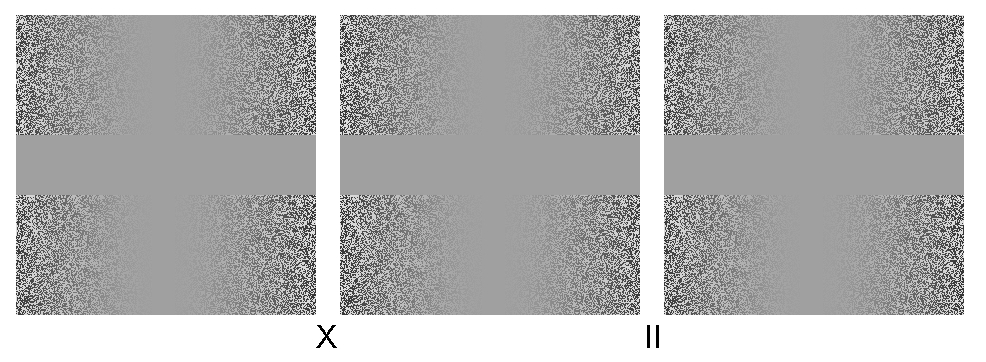
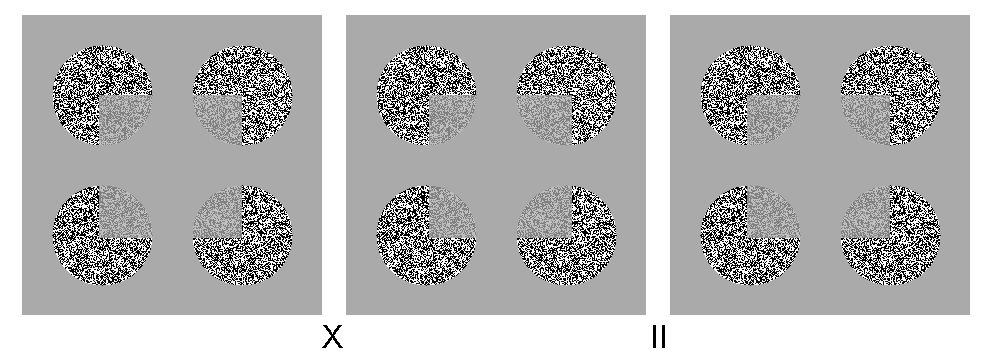
Low-contrast areas appear to be transparent and to be continual in front of the occluder.
There remains a open question whether the second-order component alone produces phantoms or not.
Envelope phantoms are continual with standard phantoms
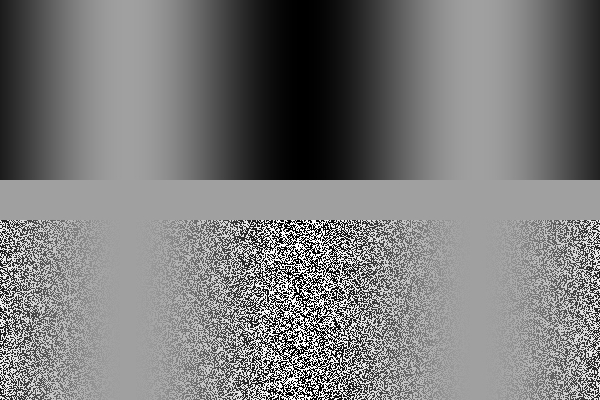
Our claim (again): Low-contrast regions give visual phantoms through perceptual transparency.
Photopic phantoms
An illusory grating in phase with the inducing gratings appears BEHIND the occluder.

Kitaoka, A., Gyoba, J., & Kawabata, H. (1999). Photopic visual phantom illusion: its common and unique characteristics as a completion effect. Perception, 28, 825-834.
Photopic phantoms involves bistable transparency.
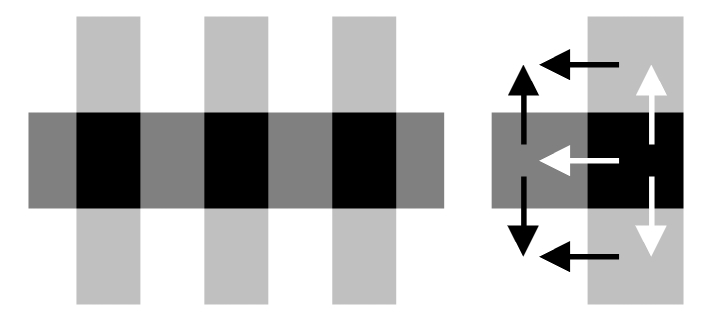
Bistable transparency
Stereoscopic enhancement of photopic phantoms
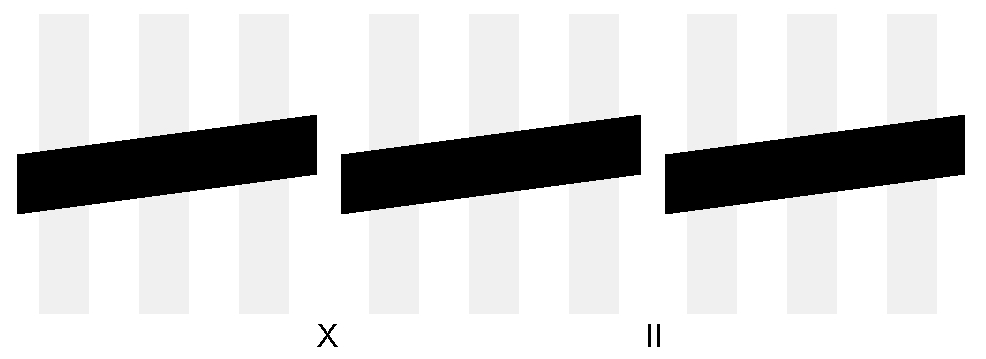
Three gray strips appear to be transparent and continual in front of the black occluder.
Our claim: There are in-phase phantoms in a stationary condition.
Two-stage model
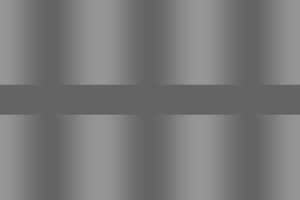
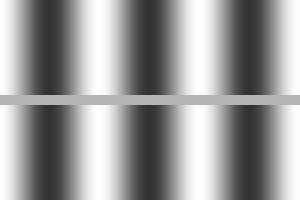


Kitaoka, A., Gyoba, J., Kawabata, H., and Sakurai, K. (2001). Perceptual continuation and depth in visual phantoms can be explained by perceptual transparency. Perception, 30, 959-968. ("Scotopic phantoms" are stationary phantoms)
Our claim: There are two stages in the process of visual phantoms. One is brightness induction; the other is perceptual transparency.
Neon phantoms
An illusory grating in phase with the thin inducing gratings appears.
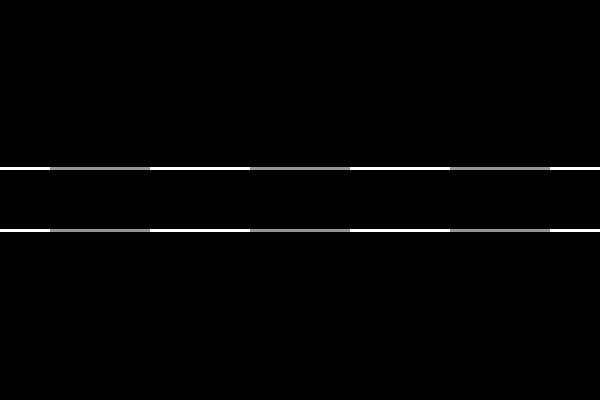
Kitaoka, A., Gyoba, J., Kawabata, H., and Sakurai, K. (2001) Two competing mechanisms underlying neon color spreading, visual phantoms and grating induction. Vision Research, 41, 2347-2354.
Neon color spreading phantoms
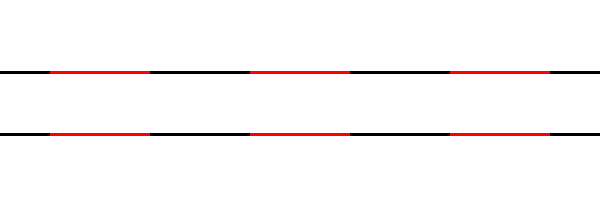
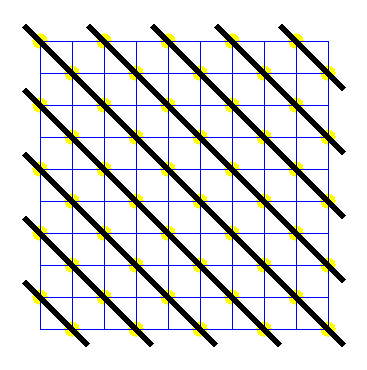
"Colored ray illusion #2"
Illusory yellow lines appear to run obliquely over the homogeneously white background.
Copyright Akiyoshi Kitaoka 2001
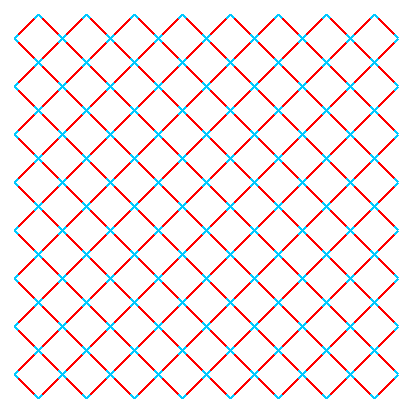
"Pincushion grid illusion1) of neon color spreading"2)
Illusory light-blue lines appear to run vertically or horizontally over the homogeneously white background. I think this phenomenon is closely related to "Spinnwebfaden"3) or "colored street"4).
Copyright Akiyoshi Kitaoka 2001
1) Schachar, R. A. (1976). The "pincushion grid" illusion. Science, 192, 389-390.
2) Kitaoka, A. (2001). Illusion designology (7): Illusory light perception that cannot be explained by the Fourier analysis. Nikkei Science, 31(8), 66-68 (in Japanese).
3) Prandtl, A. (1927). Uber gleichsinnege Induktion und die Lichtverteilung in gitterartigen Mustern. Zeitschrift fur Sinnesphysiologie, 58, 263-307.
4) Redies, C., Spillmann, L. and Kunz, K. (1984). Colored neon flanks and line gap enhancement. Vision Research, 24, 1301-1309.
Pincushion grid illusion of neon color spreading
Our claim: Neon color spreading is related to the visual phantom illusion.
Visual phantoms are related to Zavagno's glare effect
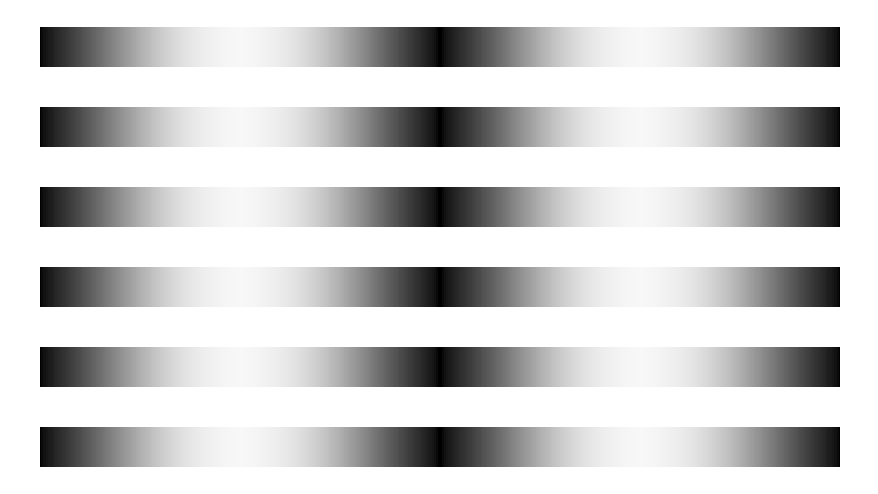
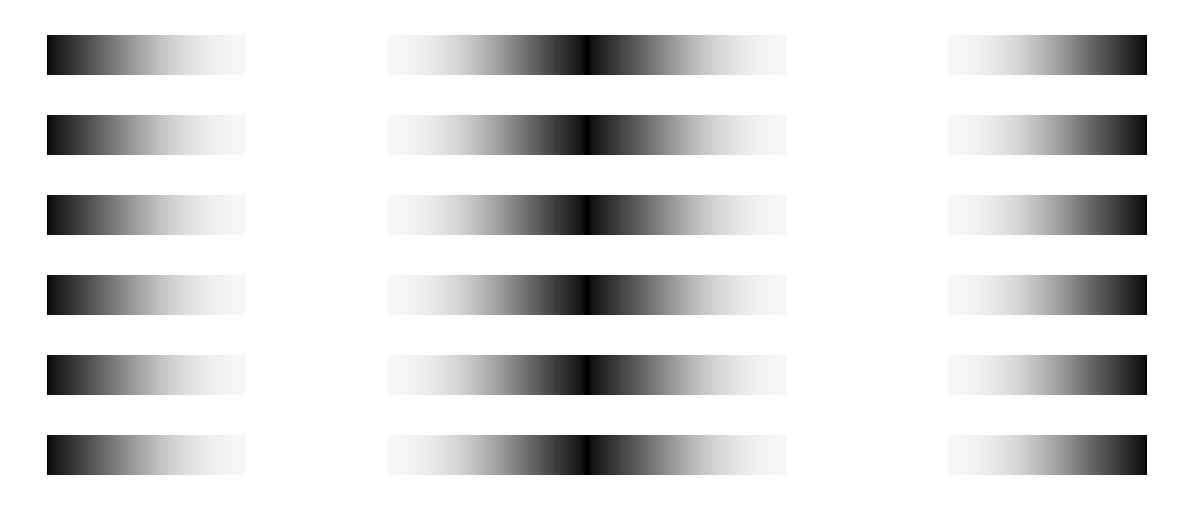
Note that the glare is brighter at a glance than the non-glare white parts, but the glare actually appears to be darker when analytically observed.
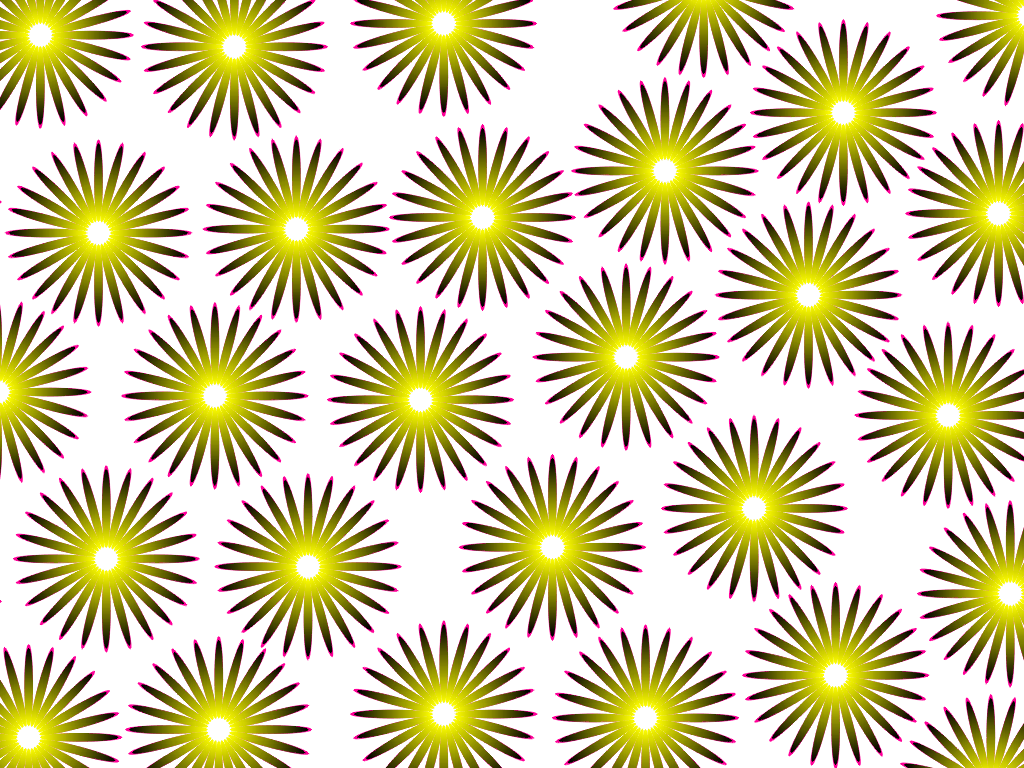
"Sea urchins"
Sea urchins appear to shed light.
Copyright Akiyoshi Kitaoka 2005 (August 11)
Thus, it is not sure whether this phenomenal glare is brighter than the background also in a low level.
Our claim: The perceived lightness of visual phantoms reflect the high-stage processing.
Craik-O'Brien-Cornsweet phantoms
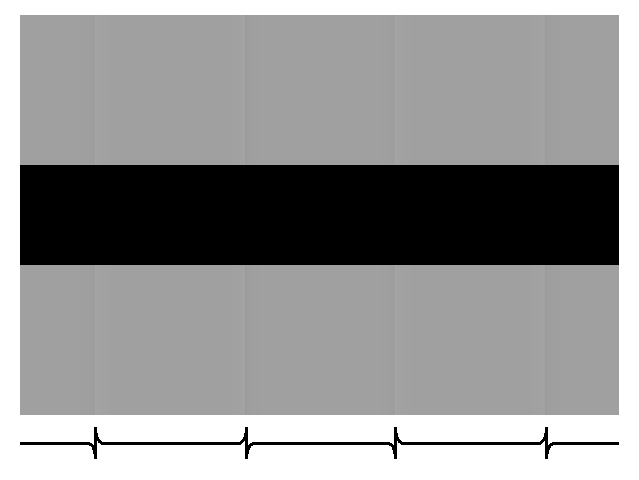
In-phase phantoms are observed behind the occluder though inducing gratings are nearly homogeneous.
Our claim (again): The perceived lightness of visual phantoms reflect the high-stage processing.
Photopic phantoms by luminance gradients
This phantom illusion also suggests that contrast polarity of photopic phantoms is not determined by the (physical) luminance of the grating but by the (perceived) lightness of the grating. I think that surface color, not film color, is completed.
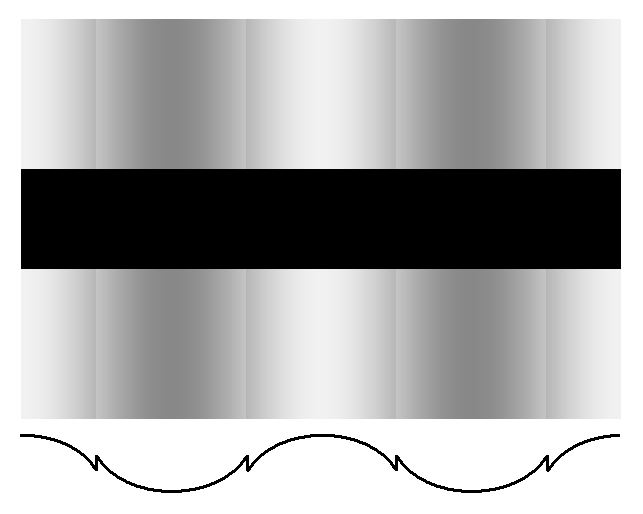
Phantoms in phase with surface color (perceived lightness), while counterphase with global luminance modulation, are observed behind the occluder.
Our claim: Surface color is completed. Surface color reflects a high-stage processing.
Conclusion: The visual phantom illusion is a phenomenon of surface completion, which is given by brightness induction (low stage) and perceptual transparency (high stage).
Muchas gracias!
Summary. The visual phantom illusion was first discovered by Rosenbach (1902 Zeitschrift fur Psychologie 29 434 - 448) and named "moving phantoms" by Tynan and Sekuler (1975 Science 188 951 - 952) because of its strong dependence on motion. Genter and Weisstein (1981 Vision Research 21 963 - 966) and Gyoba (1983 Vision Research 23 205 - 211) later revealed that phantoms can be generated by flickering the grating (flickering phantoms) or by low-luminance stationary gratings under dark adaptation (stationary phantoms). Although phantoms are much more visible at scotopic or mesopic adaptation levels than at photopic levels (scotopic phantoms), Kitaoka et al (1999 Perception 28 825 - 834) proposed a new phantom illusion which is fully visible in photopic vision (photopic phantoms). Kitaoka et al (2001 Perception 30 959 - 968) finally revealed that the visual phantom illusion is a higher-order perceptual construct or a Gestalt, which depends on the mechanism of perceptual transparency. Perceptual transparency is known as a perceptual product that depends on brightness and contrast. Kitaoka et al (2001 Vision Research 41 2347 - 2354) and Kitaoka et al (2001 Perception 30 519 - 522) furthermore manifested the shared mechanisms between visual phantoms and neon color spreading or between visual phantoms and the Petter effect. In our latest studies, the visual phantom illusion can be seen with a stimulus of contrast-modulated, second-order gratings. We assume that this effect also depends on perceptual transparency induced by contrast modulation. Moreover, we found that the Craik-O'Brien-Cornsweet effect and other lightness illusions can generate the visual phantom illusion. In these new displays, the phenomenal appearance looks like that of photopic phantoms. In any case, we explain the visual phantom illusion in terms of surface completion, which is given by perceptual transparency.
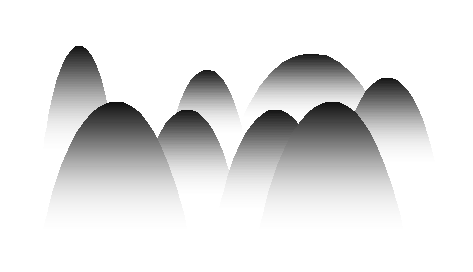
"Mountains"
The perception of mist seems to be due to light phantoms.
Copyright A.Kitaoka 2002
since August 10, 2005
